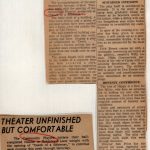
Death of a Salesman (1962)
Performances
May 22-26, 1962
Venue
Community Players Theatre
Synopsis
“Death of a Salesman” is a thrilling work of deep and revealing beauty that remains one of the most profound dramas of the American theatre. The play won the 1949 Pulitzer Prize for Drama as well as the Tony Award for Best Play. The story revolves around the last days of Willy Loman, a failing salesman, who cannot understand how he failed to win success and happiness. Through a series of tragic soul-searching revelations of the life he has lived with his wife, his sons, and his business associates, we discover how his quest for the “American Dream” kept him blind to the people who truly loved him.
Author: Arthur Miller
Historian’s Corner
Hopes were high that the board would be able to put on three plays and a possible musical in May for the 1961-1962 Season. At the November 7, 1961 board meeting, however, the Players were informed of delays in construction. The earliest show of their season could not be performed until March of 1962. It was then decided to perform in March, April and May, with no musical. The January 16, 1962 board meeting brought more sad news. Performing a three play season, due to construction delays, was now impossible. With time running out, the board set up a sub-group of Players called, “The Community Players Studio Theatre Group.” Dick Brown and Bob Price were named as co-chairmen of the group. Their mission was to give acting classes that would lead to a production in the Spring of 1962. During the March 5, 1962 board meeting, it was decided that the studio group would present the play, “Death of a Salesman” to run from May 6-12 at the Bloomington Club Building. Ticket prices were set at $1.75. Auditions were held at the YMCA on March 9th and March 11th. On April 22nd, it was decided to present the play at the partially completed Robinhood Lane Theatre. The dates were changed for the run to May 22-26. Ticket prices were also changed to $1.50 in advance and $2.00 at the door. After a successful run, the Players were now ready to finish the building for a full season of shows in 1962-1963.











